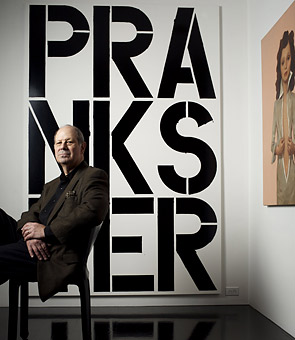
Cliff Einstein photographed with Prankster by Christopher Wool
Advertising executive Cliff Einstein and his wife Mandy have amassed one of the country's top collections of contemporary art, including works by James Turrell and Nancy Rubins. Chairman of Los Angeles' Museum of Contemporary Art, Einstein talks to Barbara Isenberg about collecting.
Barbara Isenberg: How do you describe an art collector?
Cliff Einstein: They fall into seven categories, which are, in no particular order, the decorator, possessor, scholar, trader, exhibitor, patron and influencer. I think we are all mixtures of those. Many of us start out as decorators and graduate when we buy one more piece of art than we have space for.
Are there particular questions to ask yourself when buying art?
Ask if it can play in the majors. Take the piece you're going to buy and hang it up next to something that's inarguably good. If it doesn't hold up, don't buy it. I just bought work by a relatively unknown artist, and I can put it anywhere in this collection. It may not be a Rauschenberg, but it looks like it belongs.
Is there a standard to keep in mind?
Recognize the 5% rule. No matter how much you show, nobody who sees it is likely to remember more than 5% of what they saw. So when you buy something, aim for that 5%. Aim high.
Do you encourage meeting artists prior to buying their work?
Always meet the art before you meet the artist. This isn't philanthropy or a social activity. You're buying what someone made, not who they are.
Should you stick with what you know and like?
Beware of what you like. You like it because it's familiar, and you have to look out for that. Look with your ears as well as your eyes. I don't mean, ask people what they're buying and buy that. I mean that talking about why someone bought something is more valuable than reading a one-sided review.
Do you see similarities between the worlds of art and of fashion?
If you consider fashion an expression of what's new, I would say at first exposure that art and fashion are the same. You see something new, and you don't know yet how to regard it because you've never seen it before. In time, it will either become more classical or disappear.
What if you make a mistake?
Mistakes are stepping stones. Forget about trying to have a perfect collection. If you're not making mistakes along the way, you're not progressing.
Your home is as much museum as living space, and you frequently have people coming to see your collection. Do you encourage that?
Yes. A great private collection is like a work of art. Go look at what people have put together. The great collections come from the stomach, not the head.
Do you ever sell pieces from your collection?
We sell every once in a while but only to buy more art. We never think about how fast we can sell and make money, but it's certainly fueling the art market today. People who are good at trading in another field feel they can bring culture into their lives and keep the trading gene going.
What about this crazy art market, with contemporary paintings going for $1 million or more?
Lately there's more conversation about the price of a painting than what's on the canvas. So when somebody looks at a painting today and says, "Wow," you don't know if it's a comment on the art or the price. But if that brings more people into collecting, it's a good thing.
How do you handle competition for key work?
Like everything else in life, you earn your way up the ladder. You promise the best environment for the art. You give works to museums. And you mix a great drink.